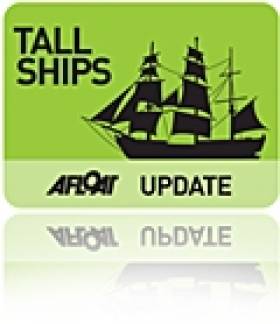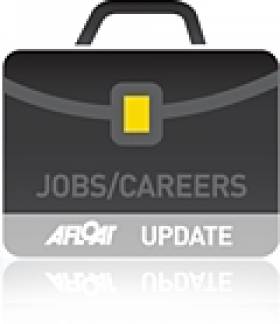Displaying items by tag: Sail Training Ireland for Youth Development Ltd
€10,000 Tall Ships Bursary for Irish Sailing Trainees
A new sailing body that claims it will ensure the continuation of the long standing Irish Tall Ships maritime tradition of youth sail training was launched at a ceremony in Dublin Port this afternoon.
The newly established Sail Training Ireland for Youth Development (STIYD) was officially launched by Nigel Rowe, President and Chairman of Sail Training International.Following the sinking of the Asgard II and the decision to wind up Coiste An Asgard, the future of sail training in Ireland had been uncertain but STIYD will now ensure the continuation of the long standing Irish maritime tradition. More Asgard II News.
At the launch Nigel Rowe also announced that Sail Training International had awarded STIYD with a bursary of €10,000 to help fund the participation of young Irish trainees in The Tall Ships Races 2011. Mr. Rowe remarked "It is wonderful to see Sail Training Ireland for Youth Development emerge from all the uncertainties and anxieties that followed the demise of Coiste an Asgard. The commitment and enthusiasm of the people who have made this happen will ensure its success, and they will have the full support of the international sail training community. With Waterford as a host port for this year's Tall Ships Races we have already committed more than €10,000 to help fund the participation of young Irish trainees."
The aims and objectives of Sail Training Ireland are to promote the development and education of young men and women through the Sail Training experience regardless of nationality, culture, religion, gender or social background as well as to sponsor and support sea-going trainees. Sheila Tyrrell, Chair of the steering group, who has a long history with sail training and in particular the Asgard remarked "We are delighted that we are in a position to formally launch the association, we are now taking applications for bursaries to allow young people to participate in the Tall Ships Race visiting Waterford later this year, and are also recruiting a manager to help manage the affairs of the association."
Also in attendance at the launch was Mr. Clayton Love Jnr., founding member of Coiste An Asgard and former President of the ISA. During the afternoons formalities Mr. Love Jnr. was officially awarded Honorary membership of STIYD in recognition of his outstanding contribution to sail training in Ireland.
Sail Training Ireland is also seeking to appoint a part-time manager to help with the development of a business plan and the day to day running of the organisations affairs. Further information on the position and a full job description can be found on the STI website www.irishsailtraining.com. Closing date for applications is Friday 22nd April.
The launch, sponsored by Arklow Shipping, was hosted by Dublin Port who are one of a number of ports supportive of the project.
All the latest Tall Ships News from Ireland.
Back from the deep. Should Asgard's bell ring out in Waterford? You decide. Poll.
New Tall Ship Sailing Body Seeks Part-Time Manager
Sail Training Ireland, the new body established by Cosite an Asgard and the Irish Sailing Association is looking to appoint a part-time manager to help with the development of a business plan for the new sailing organisation that will be officially launched in Dublin Port in a fortnight.
The appointment is offered on a self-employed basis for an initial period until 31 December 2011 after which this new position in Irish sailing may be reviewed subject to funds available. The deadline for receipt of applications is in three weeks time.
The role is on a part time basis of the equivalent of 1.5 days per week. A degree of flexibility is required.
Remuneration will be at a rate of €200 pw.
The full text of the advert publisherd today reads:
STIYD ManagerSail Training Ireland is looking to appoint a part-time manager to help with the development of a business plan and the day to day running of the organisations affaires.
Background
Since the Department of Defence declared they no longer had an interest in sponsoring the continuation of the Asgard Sail Training Programme, and the subsequent decision of the Board of Asgard to wind up the Company, a working group supported by the ISA has been working to establish a National Sail training Association.
Sail Training Ireland for Youth Development Ltd. has been established as a limited company recognised by Sail Training International as the representative body for Sail Training activities in Ireland.
The aims and objectives of the organisation are:
- To promote the development and Education of young Men and Women on the Island of Ireland in and through the Sail Training Experience regardless of Nationality, Culture, Religion, Gender or Social Background
- To promote Sail Training in the Island of Ireland and Worldwide having special regard to the promotion of and support for Sail training Vessels and their Training programmes
- To promote and encourage knowledge of all subjects associated with the sea and matters Maritime
- To sponsor and support sea-going Trainees
- To co-operate and engage with other Sail Training Associations and Organisations on the Ireland of Ireland and Internationally
- To work with Sail Training International to establish a recurring STI endorsed Tall Ships Maritime Festival every 3/5 Years.
Membership/Affiliation
Membership if STI will be open to:
- Irish Sail Training Operators
Organisations that may already exist and/or may be set up in the future.
- Supporting Organisations
Organisations that do not operate a vessel, and who support the aims and objectives of STI.
That have an interest in the development of sail training in Ireland
- Personal Members
Who would like to support the development of sail training in Ireland.
Business & Development Plan
In order to ensure the sustainability of STI, it is important that a credible plan and feasibility study is developed. This will require professional/contracted resource - funds for which may be raised through the existing goodwill and support for Ireland’s Sail Training Programme.
Key Responsibilities
1. Administrating the STI Bursary Scheme for 2011
a. Managing the payment of bursaries
b. Liaising with bursary recipients
c. Collating Reports from recipients
2. Developing a set of Rules for the Association
a. Membership/affiliation Structures
b. Procedures at meetings
c. Election of the board etc
3. Managing the accounts of the Association
a. Keep records
b. Processing of payments/income
4. Charitable Status
a. Apply for charitable status
5. Management of the Website/ liaising with the webmaster
a. Maintenance and management of content
6. Board Meetings
a. Organise meetings (venues dates etc)
b. Send out agenda
c. Take minutes
7. Business & Development Plan
a. Source/research required information
b. Draft plan
8. Membership/Affiliation
a. Develop membership/affiliation application system
b. Develop membership benefits
c. Administrate applications
d. Maintain database
9. Funding
a. Identify sources of funding, revenue generating opportunities
10. PR and Media
a. Develop media plan for STI to raise the profile
11. Queries
a. Respond to queries relating to Sail Training in Ireland
Terms and Conditions
The appointment will be offered on a self-employed basis for an initial period until 31 December 2011after which the position may be reviewed subject to funds available.
The role is on a part time basis of the equivalent of 1.5 days per week. A degree of flexibility is required.
Remuneration will be at a rate of €200 pw.
Applications
A letter of application and CV should be sent by email to:
Harry Hermon, [email protected], titled: “STIYD Application”
Closing date for applications is: Friday 22nd April. It is anticipated interviews will be held on Thursday 5th May.
Looking for further reading on Tall Ships in Ireland? Click the links below:
Click this link to read all our Tall Ships Stories on one handy page
Previewing Ireland's Tall Ships 2011 Season
Can Ireland Get a New Tall Ship?

























































